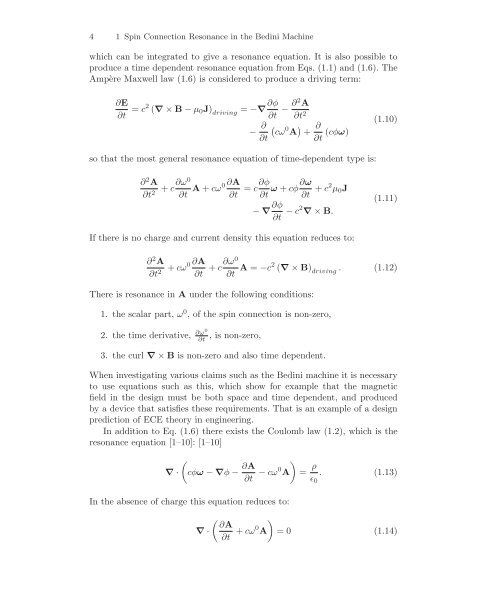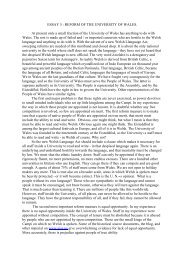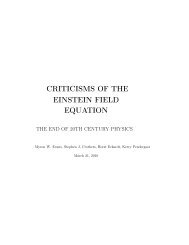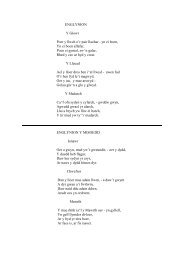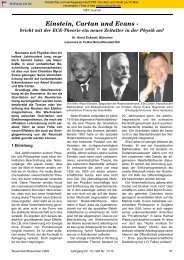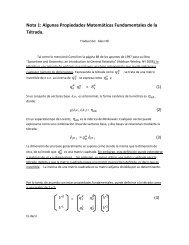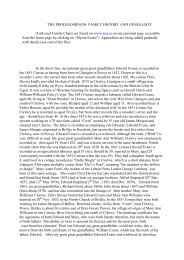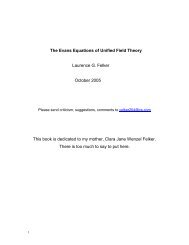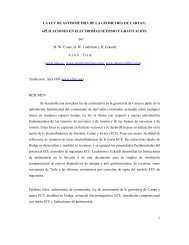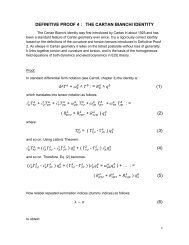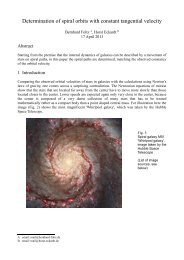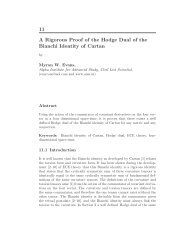Spin Connection Resonance in the Bedini Machine - Alpha Institute ...
Spin Connection Resonance in the Bedini Machine - Alpha Institute ...
Spin Connection Resonance in the Bedini Machine - Alpha Institute ...
Create successful ePaper yourself
Turn your PDF publications into a flip-book with our unique Google optimized e-Paper software.
4 1 <strong>Sp<strong>in</strong></strong> <strong>Connection</strong> <strong>Resonance</strong> <strong>in</strong> <strong>the</strong> Bed<strong>in</strong>i Mach<strong>in</strong>e<br />
which can be <strong>in</strong>tegrated to give a resonance equation. It is also possible to<br />
produce a time dependent resonance equation from Eqs. (1.1) and (1.6). The<br />
Ampère Maxwell law (1.6) is considered to produce a driv<strong>in</strong>g term:<br />
∂E<br />
∂t = c2 (∇ × B − µ0J) driv<strong>in</strong>g = −∇ ∂φ<br />
∂t − ∂2A ∂t2 − ∂ 0 ∂<br />
cω A +<br />
∂t ∂t (cφω)<br />
so that <strong>the</strong> most general resonance equation of time-dependent type is:<br />
∂2A ∂A<br />
+ c∂ω0 A + cω0<br />
∂t2 ∂t ∂t<br />
= c∂φω<br />
+ cφ∂ω<br />
∂t ∂t + c2 µ0J<br />
− ∇ ∂φ<br />
∂t − c2∇ × B.<br />
If <strong>the</strong>re is no charge and current density this equation reduces to:<br />
(1.10)<br />
(1.11)<br />
∂2A ∂A<br />
+ cω0 + c∂ω0<br />
∂t2 ∂t ∂t A = −c2 (∇ × B) driv<strong>in</strong>g . (1.12)<br />
There is resonance <strong>in</strong> A under <strong>the</strong> follow<strong>in</strong>g conditions:<br />
1. <strong>the</strong> scalar part, ω 0 , of <strong>the</strong> sp<strong>in</strong> connection is non-zero,<br />
2. <strong>the</strong> time derivative, ∂ω0<br />
∂t , is non-zero,<br />
3. <strong>the</strong> curl ∇ × B is non-zero and also time dependent.<br />
When <strong>in</strong>vestigat<strong>in</strong>g various claims such as <strong>the</strong> Bed<strong>in</strong>i mach<strong>in</strong>e it is necessary<br />
to use equations such as this, which show for example that <strong>the</strong> magnetic<br />
field <strong>in</strong> <strong>the</strong> design must be both space and time dependent, and produced<br />
by a device that satisfies <strong>the</strong>se requirements. That is an example of a design<br />
prediction of ECE <strong>the</strong>ory <strong>in</strong> eng<strong>in</strong>eer<strong>in</strong>g.<br />
In addition to Eq. (1.6) <strong>the</strong>re exists <strong>the</strong> Coulomb law (1.2), which is <strong>the</strong><br />
resonance equation [1–10]: [1–10]<br />
<br />
∇ · cφω − ∇φ − ∂A<br />
∂t − cω0 <br />
A = ρ<br />
. (1.13)<br />
ɛ0<br />
In <strong>the</strong> absence of charge this equation reduces to:<br />
<br />
∂A<br />
∇ ·<br />
∂t + cω0 <br />
A = 0 (1.14)


